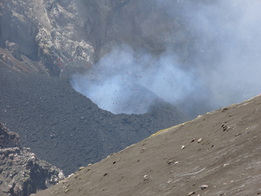 Vent in Bocca Nuova crater during activity Vent in Bocca Nuova crater during activity Way back in July 2012, three months before the official start of my PhD a research trip to Etna (see my previous post - caddying for the discovery channel) resulted in the rather fortuitous measurement of some strombolian activity in the Bocca Nuova crater of Etna. More than two years later we have published the results of the research. Using UV (ultra-violet) cameras we managed to get a short period of measurements of sulphur dioxide flux from the vent pictured in the photo on the right. Apart from estimating the mass of explosive events we also noticed an interesting trend in the data. The observed trend suggested that for larger massed explosions there was a longer delay before any explosion could occur and that smaller explosions could occur in quicker succession. For full details and the graph I refer you to the paper. It is in the process of being upgraded to full open access (or should be anyway...) so you may or may not be able to view without an institutional login! One of the questions we try to address in this paper is why this pattern/trend is observed. Among the potential explanations one that stood out in particular was related to the behaviour of gas slugs. In the paper, we show that given the estimated masses of the explosions, we can reasonably assume that the gas rising in the conduit is doing so in slug form. In the video below on the left is a happy slug rising in a conduit on its own. In this situation the base of the gas slug rises at a constant speed as the nose accelerates towards the surface prior to burst. In the video below on the right, we have two slugs rising (video is horizontal to fit more of the process in) one behind the other. As a slug rises it creates a sort of area of influence (interaction length) behind it which allows the whole of the trailing slug (including the usually constant velocity slug base) to accelerate. This then enhances the chance of coalescence between slugs which is rapid as the slug enters into the wake of the leading slug. This process is illustrated in the video on the right. So how does this create a trend involving larger massed explosions and longer wait times? Well, if larger slugs are formed by coalescence then they will have, in essence, gobbled up a number of trailing slugs to get to that size, ergo a larger slug will cause a longer delay before another explosion can occur! Again, we can't categorically rule out other ideas or hypothesis given the inherently unviewable nature of the interior of a magmatic conduit!
Of course the paper only describes the activity we witnessed and measured during this period in July 2012. For a brief spoken summary of the paper in an AudioSlides presentation, click here. Please see the references on the paper for further information.
|
Archives
July 2023
|

 RSS Feed
RSS Feed